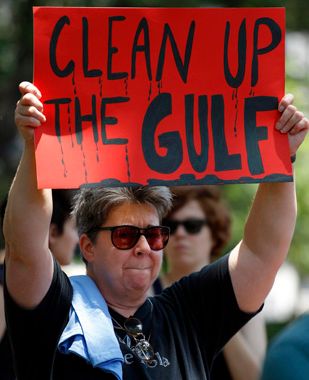BP oil containment box hits snag
Oil giant says efforts to contain oil spill have been hampered by technical obstacles.

He said BP was also considering other methods to capture the flow.
About 400 metres away is the wreckage of the drilling rig Deepwater Horizon, which BP was leasing when it exploded on April 20, blowing open the well and triggering a major environmental crisis.
Eleven workers were killed in the accident at the platform, which sank two days later.
| IN DEPTH | |
|
An estimated 800,000 litres of oil have been spewing daily ever since, in the biggest oil spill in the US since the Exxon Valdez disaster in Alaska in 1989.
The containment box had been considered the best hope of stemming the flow in the short term.
Methane bubble
The blowout was triggered by a bubble of methane gas that escaped from the well and shot up the drill column, expanding quickly as it burst through several seals and barriers before exploding, according to interviews with rig workers conducted during BP’s internal investigation.
| IN DEPTH | |||||||||||||||||||||||||||
|
While the precise cause is still under investigation, the sequence of events described in the interviews provides the most detailed account of the blast that has poured more than 11 million litres of crude into the Gulf.
According to one interview transcript, a gas cloud covered the rig, causing giant engines on the drill floor to run too fast and explode.
The engines blew off the rig and set “everything on fire”, the account said.
John Curry, a BP spokesman, would not comment on whether methane gas or the series of events described in the internal documents caused the accident.
“Clearly, what happened on the Deepwater Horizon was a tragic accident. We anticipate all the facts will come out in a full investigation,” Curry said on Friday night.
Possible options
Among the options being considered was to plug the leak by injecting ground-up material in a “junk shot”.
“It has certain issues and challenges and risks with it, and that’s why we haven’t actually progressed up to this point. But we will look and continue to see whether that’s a viable option,” Suttles, the chief operating officer, said.
| Race to stop oil flow |
|
Engineers struggling to find a way to halt the flow of oil from the damaged well are working along three paths:
|
“It’s all to do with we’re working in 5,000 feet of water in a very difficult, challenging environment.”
Public concern about the oil spill has been focused on the potential environmental and economic damage.
Workers have also sprayed dispersants over the slick to break it up and deployed hundreds of thousands of feet of boom to contain the spreading oil.
But environmentalists have warned that dispersants like Corexit were also dangerous to sea life.
“Those products don’t make the oil go away,” Joe Griffitt, a marine biologist at Gulf Coast Research Laboratory, said.
“It just falls to the sea bottom. That’s where you’ll find the sediments and the larvae. So the toxic effect is double.”
Suttles said BP had anticipated encountering difficulties with the box, but had not expected them to be as significant as a problem.
Teams were evaluating whether the issue could be overcome by providing heat, methanol or other methods.
The dome had been expected to be operational on Monday and to collect about 85 per cent of the leaking crude by funnelling it up to a barge on the surface.


 Breaking up oil
Breaking up oil